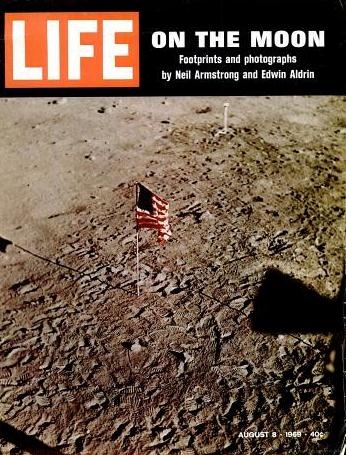Life: On the Moon
Various Small Fires presents LIFE: On The Moon, a group exhibition tracing the immediate influence and lasting significance of the epochal July 20, 1969 moon landing on the early development of Land Art, represented by Robert Smithson and Michelle Stuart, in dialogue with recent works by Christopher Badger, Trevor Paglen, Katie Paterson, and Tavares Strachan.
In August 1969, LIFE Magazine published dozens of full-page stills from films of the moonŌĆÖs surface shot by Neil Armstrong in an issue titled ŌĆ£LIFE: On The Moon.ŌĆØ The colonization and documentation of the moonŌĆÖs previously mysterious lunar landscape revealed it to be a desolate ŌĆ£non-siteŌĆØ, while also forever shifting perception of fundamental landscape concepts such as scale, distance, accessibility, and jurisdiction.
Concurrently with the military-industrial ŌĆ£space raceŌĆØ leading up to the moon landing, American artists began to experiment outside of traditional studio practice, intervening at a terrestrial scale to initiate the Land Art movement. Michelle Stuart, an early member of this movement, produced a series of haunting mixed media meditations on paper in 1969 including Magnetic Forces, exhibited here for the first time, that subtly critique the techno-scientific mandate to strip the moon of its mystery. Fellow Land Art progenitor Robert SmithsonŌĆÖs rarely noted lunar influence is illustrated by his 1972 Lake Edge Crescent proposal to transform a depleted Midwestern strip mine ŌĆ£non-siteŌĆØ into a crescent-marked earthwork resembling the moonŌĆÖs barren surface.
A selection of recent works further engage the moonŌĆÖs paradoxical post-landing status as a familiar yet inaccessible site/non-site. Christopher BadgerŌĆÖs Lunar Mirrors are polished reliefs of high-resolution NASA lunar topographical data rendered as glamorous abstractions. Badger also presents a towering 30-foot model of a lunar spire, which were commonly hypothesized to populate the moonŌĆÖs surface by 19th century European astronomers misled by crater shadows. Katie PatersonŌĆÖs Second Moon playfully addresses the moonŌĆÖs out-of-reach familiarity by sending an actual crated moon rock into ŌĆ£orbitŌĆØ around the Earth via UPS, which will make occasional stops during the exhibition to an otherwise empty pedestal at Various Small Fires, tracked otherwise via a networked touchscreen console.
Trevor Paglen uses espionage techniques to portray the military-surveillance complexŌĆÖs landscape and skyscape interventions hidden in plain site, as in Dead Military Navigation Satellite (Cosmos 985) Near the Disk of the Moon, in which a defunct top secret satellite floats for eternity as an artificial second moon. In Standing Alone, which debuted at his 2013 Venice Biennale Bahamas Pavilion, Tavares Strachan plants a flag on the North Pole in proxy of a lunar landing, as a poignant post-colonial gesture.

Recommended for you
Various Small Fires presents LIFE: On The Moon, a group exhibition tracing the immediate influence and lasting significance of the epochal July 20, 1969 moon landing on the early development of Land Art, represented by Robert Smithson and Michelle Stuart, in dialogue with recent works by Christopher Badger, Trevor Paglen, Katie Paterson, and Tavares Strachan.
In August 1969, LIFE Magazine published dozens of full-page stills from films of the moonŌĆÖs surface shot by Neil Armstrong in an issue titled ŌĆ£LIFE: On The Moon.ŌĆØ The colonization and documentation of the moonŌĆÖs previously mysterious lunar landscape revealed it to be a desolate ŌĆ£non-siteŌĆØ, while also forever shifting perception of fundamental landscape concepts such as scale, distance, accessibility, and jurisdiction.
Concurrently with the military-industrial ŌĆ£space raceŌĆØ leading up to the moon landing, American artists began to experiment outside of traditional studio practice, intervening at a terrestrial scale to initiate the Land Art movement. Michelle Stuart, an early member of this movement, produced a series of haunting mixed media meditations on paper in 1969 including Magnetic Forces, exhibited here for the first time, that subtly critique the techno-scientific mandate to strip the moon of its mystery. Fellow Land Art progenitor Robert SmithsonŌĆÖs rarely noted lunar influence is illustrated by his 1972 Lake Edge Crescent proposal to transform a depleted Midwestern strip mine ŌĆ£non-siteŌĆØ into a crescent-marked earthwork resembling the moonŌĆÖs barren surface.
A selection of recent works further engage the moonŌĆÖs paradoxical post-landing status as a familiar yet inaccessible site/non-site. Christopher BadgerŌĆÖs Lunar Mirrors are polished reliefs of high-resolution NASA lunar topographical data rendered as glamorous abstractions. Badger also presents a towering 30-foot model of a lunar spire, which were commonly hypothesized to populate the moonŌĆÖs surface by 19th century European astronomers misled by crater shadows. Katie PatersonŌĆÖs Second Moon playfully addresses the moonŌĆÖs out-of-reach familiarity by sending an actual crated moon rock into ŌĆ£orbitŌĆØ around the Earth via UPS, which will make occasional stops during the exhibition to an otherwise empty pedestal at Various Small Fires, tracked otherwise via a networked touchscreen console.
Trevor Paglen uses espionage techniques to portray the military-surveillance complexŌĆÖs landscape and skyscape interventions hidden in plain site, as in Dead Military Navigation Satellite (Cosmos 985) Near the Disk of the Moon, in which a defunct top secret satellite floats for eternity as an artificial second moon. In Standing Alone, which debuted at his 2013 Venice Biennale Bahamas Pavilion, Tavares Strachan plants a flag on the North Pole in proxy of a lunar landing, as a poignant post-colonial gesture.













